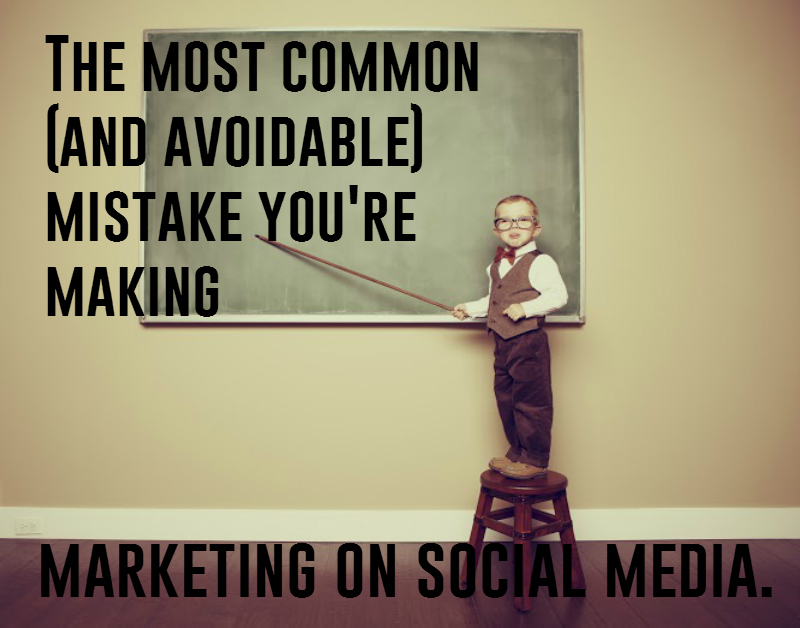
If you don’t know the difference between traditional and social media marketing best practices, you’re likely making this huge mistake.
Consider, before the internet, how did businesses promote themselves?
Some examples of traditional media are Yellow Book ads, Flyers, Radio Ads, TV Ads, Billboards.
There are hundreds of other marketing methods that pre-date the internet, all of which possess three characteristics:
- Polished, approved and proofed.
Each ad or script went through a proofing process and approval of the artwork and the language far before it ever went public.
- One way dialogue.
The dialogue is very much one-way. It rarely if ever elicits reciprocal conversation or two-way dialogue.
- It’s about selling.
The language is very much sales oriented. There’s usually the value proposition and a call to action.
Bottom line, these are sales tools that are selling.
Here’s the big difference between these types of tools and social media marketing.
Are you ready?
The biggest difference between traditional media and social media:
Social media websites are NETWORKING Tools, NOT selling tools.
It’s so important I will say it again.
Social media websites are not SALES platforms, they are NETWORKING platforms.
Social Media is different in that instead of the one-way, proofed and professional media, it’s about building relationships, creating community and trust.
One of my favourite ways to illustrate the nature of social media marketing is ask you to imagine engaging on social media as if you’re going to a networking event.
It’s virtually unheard of to come out of a networking event with a contract and a cheque.
You will come out with business cards of your new contacts who have given you permission to nurture that relationship.
You’re given an opportunity to go from someone they know, to someone they know, like and trust.
And then, when they are ready to buy what you’re selling, they will buy from you as opposed to your competition.
This is what social media marketing is all about. It’s about nurturing relationships and building community.
Why Social Media works as a sales tool:
If you’re beginning to think you don’t have time for networking and you should go back to your hard-selling or traditional marketing tools, think about this:
Consumers are getting smarter. Currently subjected to over 3000 ads a day* they’re getting sick of being sold to. Consumer behaviour has evolved and so should you if you want your business to survive.
To thwart TV ads, people use PVR technology. Unsolicited emails are blocked by spam filters. Junk mail flyers are redirected to the landfill. Cold calls are ignored with caller ID and Voicemail.
People are getting more determined to control what media they’re exposed to and it’s getting harder and harder to reach them through traditional media.
Yet these same people are spending hours a day engaging on social media websites, watching videos online and searching things on search engines like Google.
It’s human nature to want to connect with others. It’s here on social media we can connect, engage, convert and share our experiences with others.
It’s the Place– (one of the 4 P’s of the marketing mix)- to be.
If you’re looking for fish you have to go where the fish are. Similarly, if you want to get in front of your target market you need to be on social media.
Similarities between Traditional & Social Media:
Consistency– you need to be seen 7 times at least before a consumer registers your existence. Your messaging and frequency of exposure should be consistent in order to remain top of mind.
Value Statement– you will always have to clearly and concisely communicate what value you provide.
Professional- you still need to be professional, but it’s more like the casual Friday version of professional.
Differences between Traditional & Social Media:
Messaging- Traditional media tools are sales tools- social media is a networking tool. As such, your messaging needs to be more geared to getting people to know, like and trust you rather than buy from you right away.
Two-way conversation/Transparency- Because of the conversational nature of social media, consumers will steer much of the conversation. You can’t control what they post about, but you will be expected to respond in a timely manner, addressing comments both good and bad. As such yourself and your organization will become more transparent on social media than with traditional media.
Please note, consumers will be talking about you, whether or not you’re listening. You won’t be able to stop this behaviour by declining to participate. It’s better for your reputation to be present and do damage control where and if necessary.
Increased Consumer Expectation- Our culture has very much evolved to be on-demand, always-on and technology driven. The expectation is that you are on social media daily and respond within an hour.
Paid, Earned and Owned Media-
Instead of just paid media, like billboards and ads, social media offers us the opportunity for increased exposure with “earned” media.
Earned media we create that gets shared due to the value it provides to consumers.
Owned media refers to our web assets- our web page, Instagram account, Facebook pages- these are properties online which are under your control and serve as a media channel.
So you can see, there exist great opportunities for capturing your ideal client on social media.
This is an excerpt of Amazon’s top rated ebook, Social in 17 and the Social Media Training workshop of the same name.









